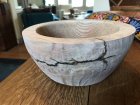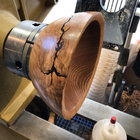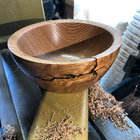- Joined
- Jul 18, 2018
- Messages
- 1,352
- Likes
- 2,930
- Location
- Baltimore, MD
- Website
- loujacobswoodturning.com
I rough turned this 9” white oak bowl this morning. Tree has been dead for a couple of years, and was taken down two days ago. This crack/bark inclusion is a neat feature that I’d love to preserve and possibly fill with epoxy or CA and turquoise or some other filler when it would be ready to re-turn. I’m also reluctant to put Anchorseal anywhere near the crack as I don’t want to compromise the potential for filler to adhere when it’s dry. The bark is much diminished, but shows on the inside of the rough turning. Is this hopeless? I’d love to hear suggestions.



